Everybody has got his or her own perception in relation to Home Remedies for Cricket Control.

Absolutely nothing is better than rest, as well as the lack thereof can lead to a host of health concerns. Nonetheless, if you have actually got crickets nearby, you can kiss a silent night farewell. They can chirp on and off for hrs, also in the middle of the night, making you freak as well as robbing you of essential rest.
If you have difficulty with these obnoxious, loud pests, you need to locate a means to get rid of them. Luckily, these 5 reliable cricket control suggestions will certainly drive them out of your house.
Replace Lights
Crickets are much less attracted to this kind of light. It would be best to have this in your entryways to prevent crickets from coming near your house.
Keep Foliage Controlled
Crickets love living in thick bushes as well as grassy areas. This dissuades crickets from clearing up close to your home.
Obtain Stacks of Clutter
Crickets can conceal in piles of bricks and other rubbish. You lure crickets with a great hiding area if you keep them on your residential or commercial property. Expert pest control experts additionally stated it would help if you also stored fire wood effectively. Because they give a risk-free sanctuary, crickets are known to comfy up to these products. It keeps them safeguard from the aspects and stops them from being seen.
Seal All Entry Things
You should focus on blocking as well as securing every little thing that could offer simple accessibility to these pests. You give them a chance to get inside your residential property if you do not. And also once they hide, you may have a challenging time discovering that irritating insect.
Execute Pest Treatments
Store-bought chemical sprays as well as powders are extremely effective in getting rid of these pests. They can also prevent the return of crickets. This obstacle will certainly discourage crickets from coming in.
It is time to look for specialist aid if you've tried every little thing however nothing functions to eliminate them and eliminate the irritating sound they make. This is the only means you can really enjoy your sleep and experience. Pleasant desires.
If you've obtained crickets close by, you can kiss a silent evening farewell. Crickets are less brought in to this kind of light. If you maintain them on your residential or commercial property, you attract crickets with a great hiding spot. Therefore, to avoid cricket problem, you should function on sealing all access points of your residence. They can also avoid the return of crickets.
How To Get Rid Of Crickets In The Garden
There’s a fine line between insects and pests, and crickets crossed it ages ago. It’s one thing to hold concerts at night, but damaging cannabis is where we draw the line. That’s why understanding how to get rid of crickets in the garden is a necessity, and we’ve got you covered.
We’ll start by filling you in on all you need to know, including how to spot signs of an infestation. We’ll then share our best cricket pest control measures and ways to keep them away. As a parting gift, there’s an FAQ section to help you find the info you need quickly.
Once you understand what you’re dealing with, you’ll get the job done speedily. Now, let’s jump straight into it.
All you need to know about crickets
How to get rid of crickets in the garden is an art that requires study. Despite being a pretty common insect, we often know little about them. That’s why we get confused during an invasion, and eliminating them becomes a challenge.
These nocturnal insects are from the order Orthoptera, distantly related to grasshoppers. You can find crickets in the garden (indoor or outdoor), forests, fields, and underground holes. There are over 900 species, including the common house, field, camel, mole, and bush crickets.
Some people eat them, others regard them as good luck, and they’re sometimes pets. Either way, any cannabis destroyer is an enemy, so knowing how to get rid of crickets in the yard comes in handy.
Cricket’s physical characteristics
Crickets have long 1–2 inch round bodies (thorax) in white, yellow, green, brown, black, or red. They have two long antennae (feelers) on top of their round head and six legs. They also have wings lying flat on their backs, even though they don’t fly.
The females have a thin tube-like structure on their abdomen (ovipositor) for laying eggs. Baby crickets (nymphs) look like adults, just tinier and without wings.
You’ll notice that the crickets in the garden have longer back legs that are thicker at the thighs—they provide the required jumping power.
Different species have small variations in their looks. For instance, the camel cricket has a hump, thus the name. All in all, they generally look the same, and you’ll recognize one when it appears.
https://homegrowncannabisco.com/grow-your-own-with-kyle-kushman/troubleshooting/get-rid-of-crickets/

Do you appreciate reading up on How to Kill and Prevent Crickets? Place a remark down the page. We would be glad to find out your thinking about this posting. In hopes that you come back again before long. Kindly set aside a second to promote this blog entry if you enjoyed it. Thank-you for taking the time to read it.
Rates